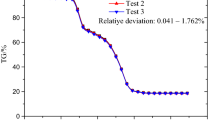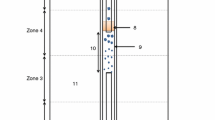Abstract
The co-firing of various ultra-low volatile coal-based solid wastes (CSWs) under oxy-fuel condition is a promising approach to elevate the energy conversion efficiency in coal chemistry industry. However, the kinetics and thermal transformation mechanisms during oxy-fuel co-combustion of various CSWs blends are still vague, which need to be further elucidated. Here, the physical–chemical features of CSWs were firstly revealed. Moreover, the oxy-fuel co-combustion characteristics and kinetics of various CSWs were investigated. The results illustrate that four chemical forms of fuel nitrogen could be obtained in pyrolyzed semi-coke (PS), while only two occurrence forms of fuel nitrogen were observed in two residual carbons, including fluidized bed gasification residual carbon (FRC) and coal-water-slurry gasification residual carbon (CRC). The reactivities of various samples could be promoted by the increasing temperature during gasification process. The combustion of volatile matter and fixed carbon could be promoted by an increase in oxygen content in oxy-fuel atmosphere. The combustion characteristic index (S) of 50% PS/50% CRC is raised by 59.3% and that of 50% PS/50% FRC is increased by only 19.0% with the oxygen concentration elevated from 30 to 40%. The effects of rising residual carbon proportion on PS/CRC blend are more obvious than those on PS/FRC blend. The additive of PS in blend could promote the combustion behaviors of residual carbon, especially on CRC. The mass loss rate of 50% PS/50% CRC blend changes significantly with the heating rate, which is greater than that of 50% PS/50% FRC blend. The average apparent activation energy (Eam) of 50% PS/50% CRC blend is lower than that of linear calculation result. The Eam of CRC could be reduced by blending PS, and the poor combustion behaviors of CRC are improved by addition of PS.
Graphic abstract












Similar content being viewed by others
References
Hou J, Wang Z, Liu P. Current practice and future projection for coal-to-SNG in China. Resour Policy. 2022;75:102376.
Yu X, Luo Z. Effect of 0–1 mm pulverized coal on desulfurization and upgrading of low grade lignite in dry cascade separation bed with compound force field. Fuel. 2022;309:122116.
Zhang Y, Xu Z, Liu D, Chen Y, Zhao W, Ren G. The influence of water occurrences in CWSs made of lignite and bituminous coal on slurrying performances. Powder Technol. 2022;398:117150.
Wang C, Wang C, Jia X, Zhao L, Wang P, Che D. NO formation characteristics and fuel-nitrogen transformation mechanism during co-firing of low-volatile carbon-based solid fuels with bituminous coal. Fuel. 2021;291:120134.
Wang C, Wang C, Tang G, Zhang J, Gao X, Che D. Co-combustion behaviors and NO formation characteristics of semi-coke and antibiotic filter residue under oxy-fuel condition. Fuel. 2022;319:123779.
Peng Z, Ning X, Wang G, Zhang J, Li Y, Huang C. Structural characteristics and flammability of low-order coal pyrolysis semi-coke. J Energy Inst. 2020;93(4):1341–53.
Yu M, Sun C, Wang L, Zang K, Li M, Zhou L, Zheng Y. Semi-coke activated persulfate promotes simultaneous degradation of sulfadiazine and tetracycline in a binary mixture. Chem Eng J. 2021;416:129122.
Wang C, Wang C, Feng Q, Mao Q, Gao X, Du Y, Li G, Che D. Experimental evaluation on NOx formation and burnout characteristics of oxy-fuel co-combustion of ultra-low volatile carbon-based solid fuels and bituminous coal. Energy. 2022;248:123578.
Zhao R, Qin J, Chen T, Wu J. TG-FTIR study on co-combustion of bituminous coal semicoke and lignite. J Therm Anal Calorim. 2020;147:1849–58.
Ding H, Ouyang Z, Zhang X, Zhu S. The effects of particle size on flameless combustion characteristics and NOx emissions of semi-coke with coal preheating technology. Fuel. 2021;297:120758.
Shaddix CR, Molina A. Fundamental investigation of NOx formation during oxy-fuel combustion of pulverized coal. Proc Combust Inst. 2011;33:1723–30.
Li S, Xu Y, Gao Q. Measurements and modelling of oxy-fuel coal combustion. Proc Combust Inst. 2019;37:2643–61.
Raheem DG, Yılmaz B, Özdoğan S. Comparison of oxygen enriched and oxy-combustion characteristics of lignite in a CFB: Modelling and experimental verification. Powder Technol. 2021;389:355–67.
Liu Q, Zhong W, Yu A. Oxy-fuel combustion behaviors in a fluidized bed: a combined experimental and numerical study. Powder Technol. 2019;349:40–51.
Qiu Y, Zhong W, Shao Y, Yu A. Reactive force field molecular dynamics (ReaxFF MD) simulation of coal oxy-fuel combustion. Powder Technol. 2020;361:337–48.
Mallapaty S. How China could be carbon neutral by mid-century. Nature. 2020;586(7830):482–4.
Yan Y, Sun R, Sun L, Zhu W, Chen D, Qi H, Wu J. Determining the optimum fuel concentration for ignition and combustion of semi-coke and bituminous coal blends with rich/lean burner. J Energy Inst. 2022;100:225–36.
Zhang J, Wang C, Jia X, Wang P, Che D. Experimental study on combustion and NO formation characteristics of semi-coke. Fuel. 2019;258:116108.
Wang C, Feng Q, Mao Q, Wang C, Li G, Che D. Oxy-fuel co-combustion performances and kinetics of bituminous coal and ultra-low volatile carbon-based fuels. Int J Energ Res. 2020;45(2):1892–907.
Burra KRG, Liu X, Wang Z, Li J, Che D, Gupta AK. Quantifying the sources of synergistic effects in co-pyrolysis of pinewood and polystyrene. Appl Energ. 2021;302:117562.
Li J, Burra KRG, Wang Z, Liu X, Gupta AK. Co-gasification of high-density polyethylene and pretreated pine wood. Appl Energ. 2021;285:116472.
Wang C, Gao X, Tang G, Zhao L, Mao Q, Du Y, Che D. Thermogravimetric study on oxy-fuel co-combustion characteristics of semi-coke and antibiotic filter residue. J Therm Anal Calorim. 2022;147:9505–22.
Yao H, He B, Ding G, Tong W, Kuang Y. Thermogravimetric analyses of oxy-fuel co-combustion of semi-coke and bituminous coal. Appl Therm Eng. 2019;156:708–21.
Wang C, Wang C, Jia X, Gao X, Wang P, Feng Q, Che D. Experimental investigation on combustion characteristics and kinetics during co-firing bituminous coal with ultra-low volatile carbon-based solid fuels. J Energy Inst. 2021;95:87–100.
Zheng S, Hu Y, Wang Z, Cheng X. Experimental investigation on ignition and burnout characteristics of semi-coke and bituminous coal blends. J Energy Inst. 2020;93:1373–81.
Jayaraman K, Kok MV, Gokalp I. Pyrolysis, combustion and gasification studies of different sized coal particles using TGA-MS. Appl Therm Eng. 2017;125:1446–55.
Jayaraman K, Kok MV, Gokalp I. Thermogravimetric and mass spectrometric (TG-MS) analysis and kinetics of coal-biomass blends. Renew Energy. 2017;101:293–300.
Jayaraman K, Kök MV, Gökalp I. Combustion mechanism and model free kinetics of different origin coal samples: thermal analysis approach. Energy. 2020;204:117905.
Qi H, Sun R, Peng J, Meng X, Cao Z, Wang Z, Ren X, Yuan M, Zhang L, Ding S. Experimental investigation on the ignition and combustion characteristics of pyrolyzed char and bituminous coal blends. Fuel. 2020;281:118732.
Zhao R, Dai R, Chen T, Qin J, Zhang J, Wu J. Investigation on combustion, gaseous pollutants emission and ash characteristics during co-combustion of semicoke and coal slime. J Environ Chem Eng. 2021;9:106249.
Kok MV, Varfolomeev MA, Nurgaliev DK, Kandasamy J. Application of TGA-MS technique for oil shale characterization and kinetics. J Therm Anal Calorim. 2022;147:10767–74.
Boumanchar I, Chhiti Y, M’Hamdi Alaoui FE, Elkhouakhi M, Sahibed-dine A, Bentiss F, Jama C, Bensitel M. Investigation of (co)-combustion kinetics of biomass, coal and municipal solid wastes. Waste Manage. 2019;97:10–8.
Kok MV, Ozgur E. Characterization of lignocellulose biomass and model compounds by thermogravimetry. Energ Source Part A. 2017;39:134–9.
Wang C, Zhao L, Yuan M, Liu C, Wang C, Zhao L, Wang P, Che D. Effects of ashing method and blending on ash characteristics of pyrolyzed and gasified semi-cokes. Fuel. 2020;271:117607.
Li L, Chen S, Wang S, Tao X, Zhu X, Cheng G, Gui D. Influence of pickling on the surface composition and flotability of Daliuta long-flame coal. Powder Technol. 2019;352:413–21.
Wang P, Wang C, Yuan M, Wang C, Zhang J, Du Y, Tao Z, Che D. Experimental evaluation on co-combustion characteristics of semi-coke and coal under enhanced high-temperature and strong-reducing atmosphere. Appl Energ. 2020;260:114203.
Acknowledgements
The authors acknowledge financial support from the National Natural Science Foundation of China (No. 52176129).
Author information
Authors and Affiliations
Corresponding author
Additional information
Publisher's Note
Springer Nature remains neutral with regard to jurisdictional claims in published maps and institutional affiliations.
Rights and permissions
Springer Nature or its licensor holds exclusive rights to this article under a publishing agreement with the author(s) or other rightsholder(s); author self-archiving of the accepted manuscript version of this article is solely governed by the terms of such publishing agreement and applicable law.
About this article
Cite this article
Wang, C., Wang, C., Zhao, L. et al. Oxy-fuel co-combustion characteristics and kinetics of various ultra-low volatile coal-based solid waste blends. J Therm Anal Calorim 147, 15017–15032 (2022). https://doi.org/10.1007/s10973-022-11692-y
Received:
Accepted:
Published:
Issue Date:
DOI: https://doi.org/10.1007/s10973-022-11692-y




